There are a few uncommon and rare dollar bills for serious collectors you need to be on the lookout for.
Most of you have seen a 2 dollar bill in the wild, but have you spotted a 1000 dollar bill or even a 100,000-dollar bill?
Did you even know these bills existed?
And I bet some of you never even considered looking at the serial numbers on paper currency.
Depending on the digits and their alignment, they can be rare and extremely valuable.
Let’s look at the rare and uncommon dollar bills, so you’ll be ready to add one to your collection.
The 2 Dollar Bill
The 2 dollar bill is the black sheep of the monetary family.
Like dollar coins and half-dollars, Americans seem to ignore the fact that 2 dollar bills exist.
Dollar coins and half-dollars at least work in most vending machines, but finding a vending machine that accepts a 2 dollar note is virtually unheard of.
Because Americans universally prefer 1 and 5-dollar bills, 2s are rarely seen in circulation, and when they are, it can cause problems for the spender.
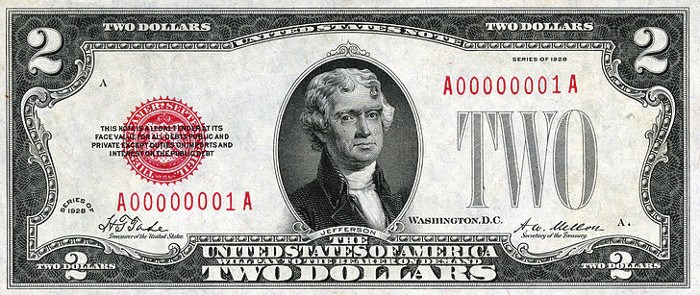
The 2 Dollar Bill is Real, Folks
The idea that 2 dollar bills are rare or nonexistent is a common misconception.
But we assure you 2 dollar bills are quite real and can be worth more than face value.
There’s an informative book on the 2 dollar bill by John Bennardo called 2 Dollar Bills: America’s Forgotten Currency.
It is worth a read for those interested in the 2 and why it has fallen out of favor even though it’s still in circulation.
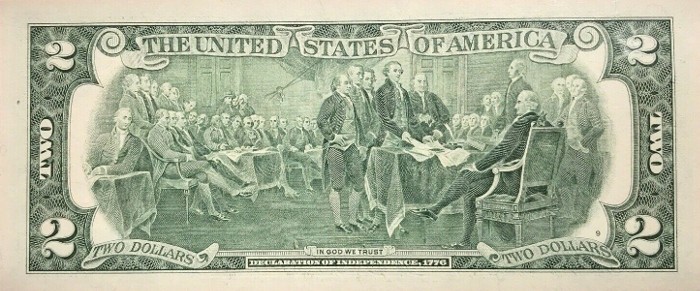
The Beginnings of the 2 Dollar Bill
The first 2 dollar bills were printed in 1862 as large-sized Legal Tender Notes and measured 7 3/8″ x 3 1/8″.
The National Bank Note Company published the bills instead of the Federal Bureau of Engraving and Printing.
The 2 dollar bills originally had Alexander Hamilton’s portrait on the front instead of Thomas Jefferson’s.
On the back were intricate scroll patterns and large 2’s in the corners.
Legal Tender for All Debts, Public and Private
This statement appeared in the center on the back:
“This note is a LEGAL TENDER for all debts public and private except duties on imports and interest on the public debt and is receivable in payment of all LOANS made to the United States.”
Because laborers made little money at the time, perhaps a dollar a day, 2 dollar bills were comparatively valuable.
At that point in history, inflation helped the 2-dollar bill become more widespread, as it slowly became a reasonable daily wage for a worker.
It was also the same period as the gold certificate.
From 1863 to 1933, each gold certificate was a title and credit to the actual list price of the gold in the amount shown on the paper currency.
Changing 2 Dollar Bill
In 1875, the 2 dollar bill took on the Lazy Deuce design with a giant 2 on the front in the top right corner.
In 1896, the 2 was an “educational series” as a silver certificate.
This series is considered the most beautiful money ever printed by the federal government.
For the 2, the back featured portraits of Robert Fulton, who invented the steamboat, and Samuel Morse, who created the Morse Code.
The design on the front depicted the personification of science, presenting steam and electricity to commerce and manufacturing.
Most Valuable $2 Silver Certificate
Two-dollar silver certificates can be worth over $1,000. More common 2-dollar silver certificates are valued from $50 to $100.
They were only printed in four years, 1886, 1891, 1896, and 1899.
The most common silver certificate is the George Washington “Mini Porthole,” printed in 1899.
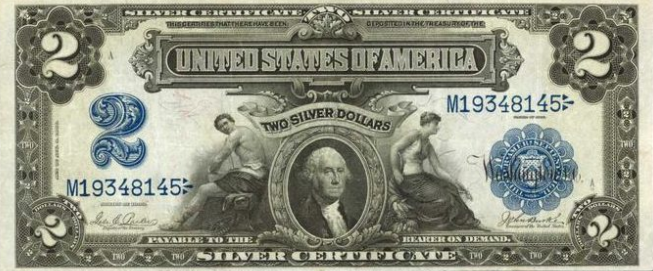
When Did They Stop Making 2 Dollar Bills?
By 1966, the U.S. Treasury Department had stopped producing the 2 dollar bill.
It didn’t reemerge until 1975 for the Bicentennial series in 1976.
When the 2 was reissued, the seal had changed to green to indicate they were now Federal Reserve Notes instead of Legal Tender Notes.
While the front was the same as in 1966, the reverse featured an ornate depiction of John Trumbull’s famous painting of the signing of The Declaration of Independence.
This version of the bill is still in circulation today.
Star Notes
There’s one caveat to 2 dollar bill values: star notes. Star replacement notes were banknotes that experienced some production error.
Since serial numbers cannot be legally duplicated, these replacement notes get a little star next to the serial number.
Uncirculated examples from 1976 and later star notes can be worth over $100, while circulated examples might fetch $10.

Since the star note system began in 1910, 2 dollar paper bills were produced back then that can also be star notes.
These are even rarer and more valuable because of combinations of specific signatures.
Bills were printed during the short time when Treasurer of the United States W.O. Woods and Secretary of the Treasury Ogden L. Mills were in office together.
A 1928-B star note with their signatures can be worth thousands and tens of thousands of dollars.
Uncirculated Star Notes
Because these notes are so scarce, the value of one in uncirculated condition would be whatever it could fetch at auction.
Any star note from the 1928 series of 2 dollar bills is a valuable and rare find. Even the least valuable, a 1928-G star note in circulated condition, is worth at least $80.
For the left side red seal 1953 star notes, you might get $18 on the low side for a circulated 1953-C and nearly $100 for an uncirculated 1953 or 1953-C.
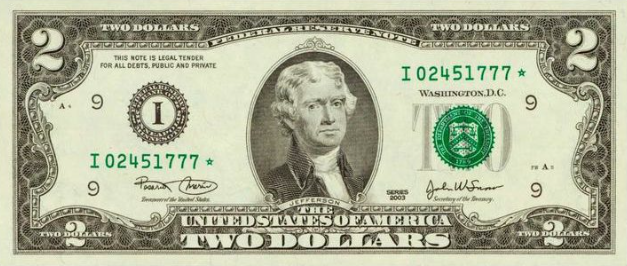
The 1963-A star notes with the red seal on the left side can also be worth nearly $100 in uncirculated condition and circulated in 1963, and 1963-A star notes are generally worth about $10 to $15.
If you’re looking for a 2 dollar bill that’s even rarer than a standard 2, later star notes are an excellent place to start.
The 500 Dollar Bill
The 500 dollar bill featured the 25th president of the United States, William McKinley.
Most $500 bills are in the hands of collectors rather than the general public nowadays.
The cash printing officially stopped in 1945 and was formally discontinued by the Federal Reserve Bank in 1969.
Although collectors scramble for the 500-dollar bill, and most people have never seen one in circulation, they remain legal tender.
If you find one in the wild, save it. But don’t fold it into your wallet, keep it flat and in good condition.
Even a 500 dollar bill in fair condition is worth 30% – 40% more than the face value.
That’s a pretty nice investment return on a single piece of paper currency.
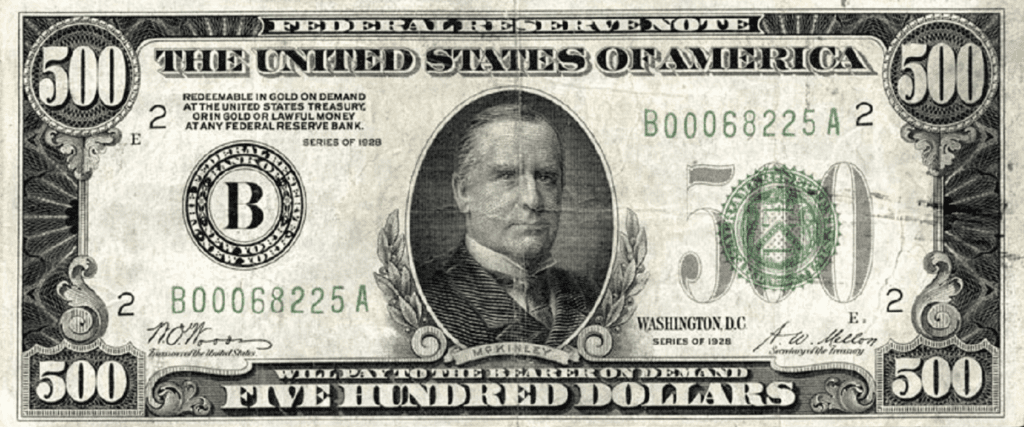
History of the 500 Dollar Bill
The 500 dollar bill began during the Civil War when the Bureau of Engraving and Printing decided to issue the first one in 1862.
The bill featured the Secretary of the Treasury, Albert Gallatin. Another version of the 500 dollar bill followed with the face of William McKinley.
The most common 500 dollar bill was the 1934 Federal Reserve Note with William McKinley on the front.
900,000 bills from 1934 were printed, but Engraving and Printing information shows only 75,000 are still circulating today.
Also included on the bill were John Quincy Adams, Abraham Lincoln, DeWitt Clinton, William Learned Marcy, and Alexander Hamilton.
At one point, there was a scene of Hernando de Soto discovering the Mississippi River.
How Much is a 500 Dollar Bill Worth?
A 500 dollar bill in good condition can be worth $600 – $1,500. Gold certificate $500 notes are valued in the thousands or tens of thousands.
Another desirable and rare issue is the 1928 500 dollar bill with a star symbol at the end of the serial numbers.
1928 bills in good condition with the star can be valued at over $10,000.
A popular year for the star note was 1934, and finding these notes is relatively easy. Values for the 1934 star note are based mostly on condition alone.
500 Dollar Gold Certificate
The gold certificates from 1928 are also extremely valuable. It was the last year the Federal Reserve System issued gold certificates.
These certificates have ‘GOLD’ stamped in gold letters across the front of the bill.
The 1882 version of a $500 gold certificate note from 1882. Rare bills in fine condition are valued in the hundreds of thousands.
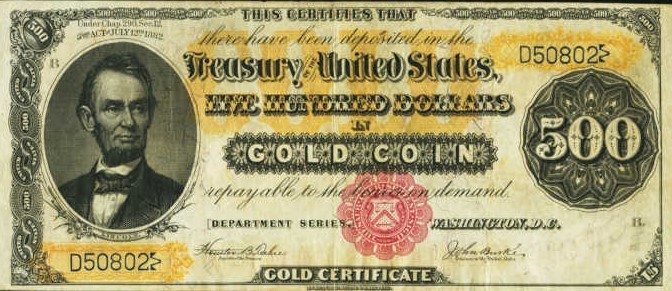
The 1000 Dollar Bill
You might have seen a 100 and even a 500-dollar bill in the wild, but chances are, you’ve never seen a 1000 dollar bill.
There was a time when the 1,000-dollar bill was legal cash currency.
First issued when the U.S. was still 13 colonies, the 1000 Bill helped fund the Revolutionary War.
Issued from 1775 to 1779, the Continental Congress printed massive amounts of high-denomination bills but needed to back them with gold or silver.
It was only a short time before the 1000-dollar bill was worth much less than face value.
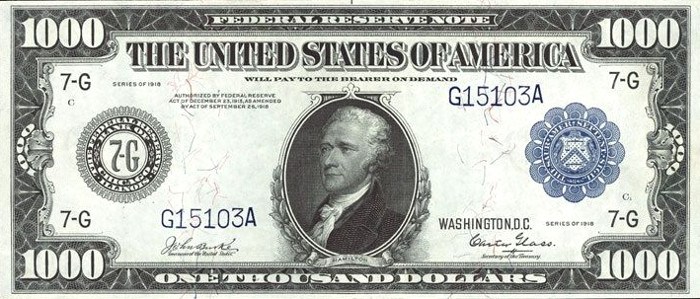
Who’s On the Thousand-Dollar Bill?
But the U.S. Government would call on the $1,000 again nearly 100 years later when Civil War broke out. President Andrew Jackson was featured on the bill.
Not only did the U.S. print the 1,000, but the Confederacy also decided to issue their own 1000 dollar bill.
The bills were reissued in 1918, featuring founding father President Alexander Hamilton, and in 1934, featuring U.S. President Grover Cleveland.
Three gold certificate bills were also printed, reflecting the Federal Reserve’s gold standard, which ended in 1933.
After the Civil War, the 1,000-dollar bill was mainly used for large business transactions, such as real estate deals or bank transfers.
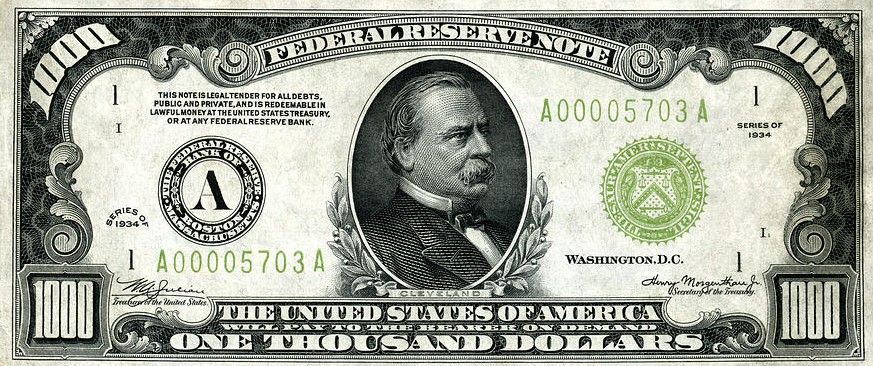
President Richard Nixon ordered the 1,000 dollar bill eliminated in 1969, with the theory that criminals used the bills for illegal activity and money laundering.
The reverse of the 1000-dollar bill included a bald eagle clutching an American flag on the 1918 issue.
While the 1928 and 1934 bills featured the printed words “The United States of America.”
Cost-cutting measures and lack of use by the general public forced the Bureau of Engraving and Printing to end the 1,000-dollar bill in 1945.
By 1969, the Federal Reserve Bank recalled all high-denomination bills.
1000 Dollar Bill Values
1918 $1000 Bill – Worth $10,000 in good condition and can exceed $100,000 in excellent condition.
1907 $1000 Gold Certificates and 1922 $1000 Gold Certificates – Values are between $15,000 and $35,000 but may exceed $100,000 depending on condition.
1928 $1000 Gold Certificate Bill – Circulated bills are valued between $3,000 and $5,000.
Bills in uncirculated condition and bills with low serial numbers can be valued at over $10,000.
1928 $1000 Federal Reserve Note: Good condition 1000 bills from 1928 are worth between $3,000 and $10,000.
1934 $1000 Federal Reserve Note – Circulated note values are $2,000 – $4,000. In comparison, the star note is slightly more than that. Notes, including a lime green seal, are even more rare and valuable.
Most Expensive 1000 Dollar Note
An extremely rare 1890 series treasury note called “The Grand Watermelon” sold for $3.3 million at auction.
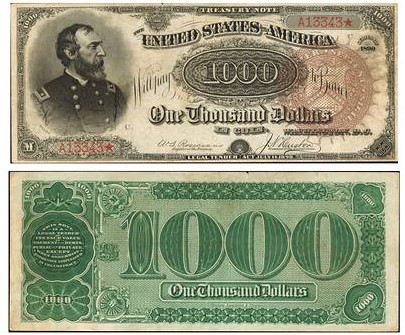
5000 Dollar Bill
Are you a collector running out of ideas for your next rare item? I have an idea for you. The 5,000 dollar bill.
Once used for large bank transfers and real estate transactions, the 5000-dollar bill is one of the rarest paper currencies in history.
Because there are only a few hundred 5000 dollar bills still around, even in poor condition, they will be worth at least $30,000.
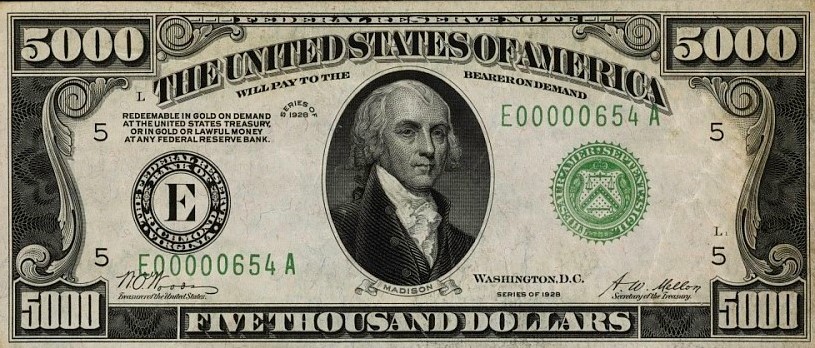
Because the 5000 dollar bill was not used heavily, most are in fair condition or better. A note in uncirculated condition can sell for over $100,000.
Auctions sometimes feature $5,000 bills, mainly from the 1928 and 1934 series.
Only ten 1928 5,000 dollar bills are known to exist. Great wealth can be found in a well-preserved 5000 bill.
The 1934 series is more common than the 1928 series. Auction sales for 5000 dollar bills in very fine condition can range around $75,000.
And uncirculated condition notes will sell for more than $160,000.
During a 2023 auction, the final sale price was $250,000 for a PMG 64 Choice Uncirculated 1934 $5,000 Federal Reserve Note.
There are only 5 graded higher than this 5000 dollar bill note, and just 28 total examples exist.
10,000 Dollar Bill
President Lincoln’s Secretary of the Treasury appeared on the 10,000 dollar bill.
And for those unfamiliar with the Treasury Secretary from those days, he was Salmon P. Chase.
Salmon Chase was notable because he was one of the people who served as the Secretary of the Treasury, U.S. Senate, Governor of Ohio, and was the sixth chief justice of the U.S. Quite the resume!
The 10000-dollar bill was the highest U.S. currency denomination to circulate publicly.
Today, only 350 $10,000 bills are in circulation, belonging to wealthy collectors or displayed at museums.
Again, much like the 1000 and the 5000 dollar bills, 10,000 dollar bills were mainly used for bank transactions.

Among the rarest of the 10,000-dollar bills are the 1928 series. Only eight are known in existence.
Two are in museums, and the others are dispersed among lucky collectors.
Values for the 10000 bill range from $30,000 to almost $400,000.
A 1934 U.S. banknote 10,000 dollar bill was recently sold at a Heritage Auction for $385,000.
100,000 Dollar Bill
The 100,000 dollar bill was never intended for public circulation.
Featuring Woodrow Wilson on the front, the 100,000 dollar note was a gold certificate from the Bureau of Engraving and Printing created during the Great Depression in 1934.
The purpose of the 100,000 dollar bill was for transactions between Federal Reserve banks.
Printing lasted only about one year and was issued by the Treasurer of the U.S. to be held against gold bullion at the Department of the Treasury.
When wire transfers were invented in the 1960s, there was no need for such large paper currencies, and the government destroyed 42,000 examples.

Not only was the 100,000 dollar bill never intended for public circulation, but every one of the surviving bills is accounted for and in possession of the U.S. Government.
It’s illegal to own a 100,000 dollar bill privately. If you’re a collector, you cannot legally own a $100,000.
If you want a glimpse of an actual 100,000-dollar bill, an uncut sheet of 12 bills is displayed at the Federal Reserve Bank of San Francisco.
There’s also a bill at the Federal Reserve Bank of Richmond, the Smithsonian Institution, and the Bureau of Engraving and Printing.
Fancy Serial Numbers and Rare Dollar Bills
Fancy serial numbers on paper currency can be valuable and worth money to the right collectors.
The problem is there are so many types of rare fancy currency that it takes a lot of work to keep track.
Here’s a brief description of some common fancy serial numbers on U.S. dollar bills.
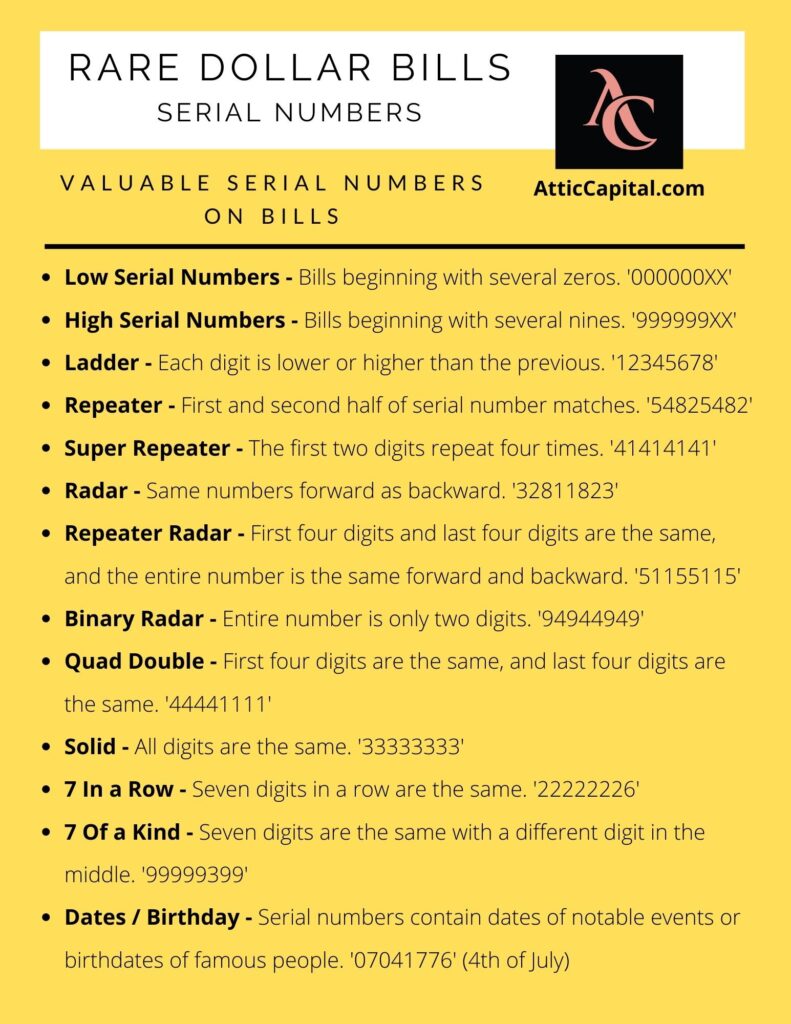
Binary Dollar Bill
One of my favorite rare dollar bills is the binary dollar bill.
With a one in 8,800 chance of finding one, they are not the rarest bills in the world, but they are still exciting.
The binary dollar bill features only serial numbers one and zero. Collectors on eBay go wild for the binary bill, with values based on the pattern of the digits.
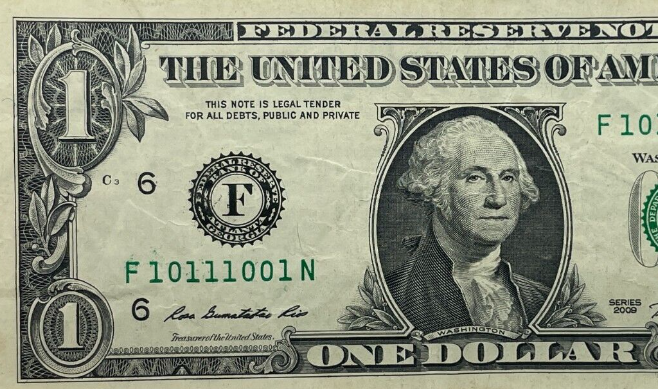
The Ladder Dollar Bill
One of the rarest dollar bills of all time is the ladder.
Only one in 95 million bills include ladders, where the serial numbers follow the standard numerical pattern in order from one to eight. (12345678)
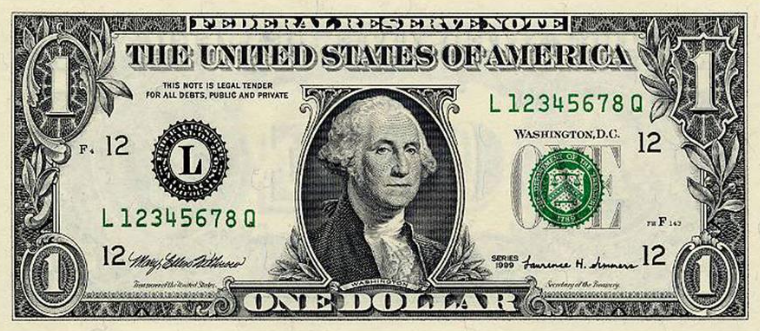
Collectors also consider variations of the ladder patterns valuable, such as backward numerical order, up and down ladder serial numbers, or a few zeros in front of the ladder.
Solid Serial Numbers
The solid serial number dollar bills have all eight digits matching.
The same number all the way across. Values range from a few hundred dollars to over $30,000, depending on the condition.

Radar Serial Numbers
Radar serial numbers might be my favorite of all. That’s because the numbers are a palindrome, read the same forward as backward.
I’m a big fan of palindromes in general, and this kind of super radar dollar bill is awesome.
Prices range from $200 to $1,500.

Super Radar Serial Numbers
And just like the radar serial numbers, super radar is when the serial number is a palindrome, only the end two digits are different.
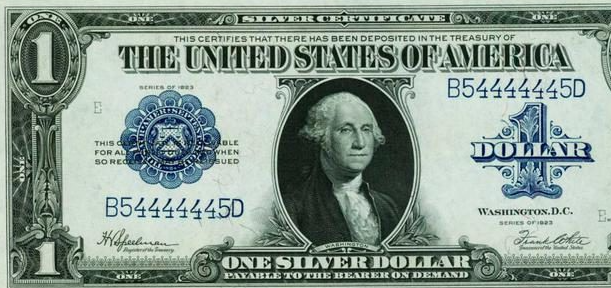
Super Repeater Serial Numbers
The super repeater dollar bill occurs when the first two digits repeat to the end of the serial number.
Values can be as low as $30 and up to hundreds of dollars.
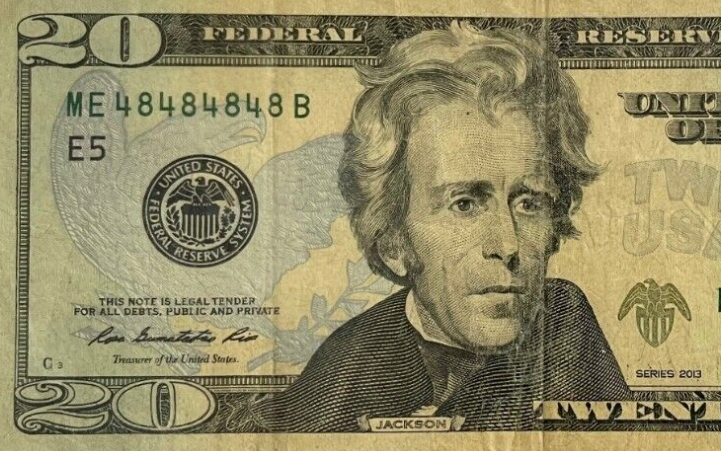
Seven In a Row Serial Numbers

Double Quads
Bills with double quad serial numbers are exactly what you might expect.
The first four serial numbers of the same digit, and the last four numbers with a different matching digit.
I found a double quad one-dollar bill selling on Etsy for $300—serial number D88883333A.
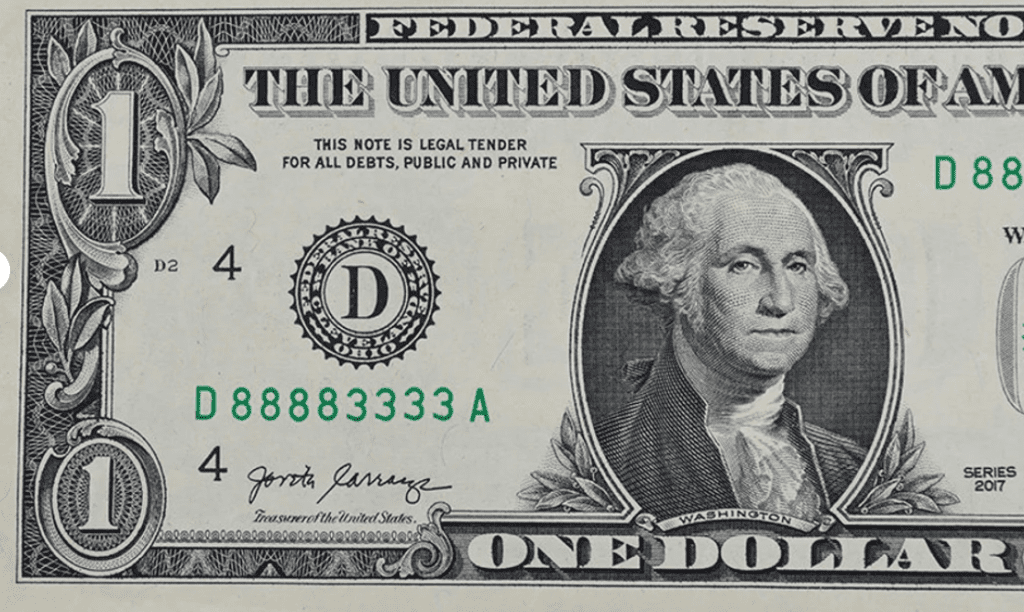
Rare Dollar Bill Misprints
In 2014 and again in 2016, more than 6 million dollar bills were issued with a printing error showing duplicate serial numbers. As you can imagine, collectors are scrambling to match up the misprints.
But it’s an enormous task, matching serial numbers on a one-dollar bill.
It could take years or even decades.
To date, only nine pairs of matching dollar bill serial numbers have been identified and are worth up to $150,000, depending on their condition.
The Federal Reserve Bank of New York stamped bills will have a capital “B” in the middle and a star after the serial number.
1928 2 Dollar Bill
Next, we arrive at the smaller, more modern 2-dollar bills.
For series 1928–1952, you can expect about $60 for a circulated example and up to $100 for a crisp, uncirculated one.
For 1953–1962 examples, a circulated note should be worth about $10, and an uncirculated one worth up to $25.
Circulated notes from 1963 are worth about $9, and uncirculated ones are worth $20.
For the 1976 and later bills, the value will depend on several factors, but in general, circulated examples are worth face value, and uncirculated examples can be worth anywhere from $5 to $10.
These are the most common, and the values are the same for series 1976, 1995, 2003, 2003A, 2009, and 2013.

The 2 Dollar Bill: Current Status
Federal Reserve Banks have 1.4 billion 2-dollar bills in circulation at the end of 2020.
How can they be so rare that most cash registers don’t even have a slot for 2s? Several factors are at play.
First of all, other denominations of paper money are far more common.
The 100-dollar bill, for example, had 16.4 billion notes in circulation as of 2020.
The Bicentennial Bills
Another problem is that when the 2 dollar bill was reissued in the 1970s, much like the quarters minted for the bicentennial celebration in 1776–1976, people hoarded them, believing they would become a collector’s item and increase in value.
Even though over half a billion 2 dollar bicentennial bills were created, it’s lower production than other paper money.
The result was relatively fewer than 2 dollar bills would circulate.
How Much Are 2 Dollar Bills Worth?
Values are everywhere with 2 dollar bills, depending on their year and condition.
One thing you can count on, though, is the earlier the 2, the more of a valuable collector’s item it is.
Well-circulated 2-dollar bills from 1862–1918 usually cost around $100, while uncirculated examples can be worth anywhere from $500 to thousands of dollars.
However, these larger bills are rare, and collectors must watch out for counterfeiters. Bills that are said to be old but appear very worn could be fakes.
The 2 Dollar Bill in the 20th Century
Even though the 2 dollar bill had been in continuous production since the Civil War, after the turn of the Century, it started to fall out of favor with the public in the early part of the 1900s.
Casinos thought they were bad luck, race tracks wouldn’t accept them for wagers, and inflation made them increasingly irrelevant.
Despite these issues, the 2 would persist. A new design appeared in 1928 on the smaller-size United States note measuring 6.14″ x 2.6″.
2 Dollar Bill Update With Thomas Jefferson
The updated version featured a portrait of Thomas Jefferson in the center of the front and a red seal that started on the left side of the note but moved to the right in 1953.
A depiction of Jefferson’s Monticello home occupied the bill’s reverse side.
Unfortunately for the 2, it had acquired a reputation as the denomination of choice for political bribes by this point.
It also saw much use for gambling at the race track since the minimum standard bet was two dollars.
But most Americans preferred the simplicity of dividing by five when making change and preferred five 1 dollar bills or one 5 dollar bill to dealing with a 2.
Even half dollars made more sense than 2 dollar bills.

Too Interesting to Ignore
The 2 dollar bill has a complicated history with the American public.
Numismatists and collectors of rare currency and rare coins seem to appreciate this odd duck of a paper bill most.
Spending a 2 dollar bill can lead to conversations, confusion, or even land the spender in trouble.
Many people think that 2 dollar bills aren’t worth dealing with, which means they usually end up in a secret stash or the hands of collectors.
If you end up with 2 dollar bills in your pocket change, look through them to find any particularly valuable examples. There could be a few worth a lot of money.
After that, decide whether to hide the rest away or trade them in at your local bank for more readily spendable cash.
Learn More About Rare Currency and Coins –
- Want to sell your coins and rare currency online, but not sure how to do it?
- How much is my rare coin and currency collection worth?
- The basics of U.S. coin denominations over the years.
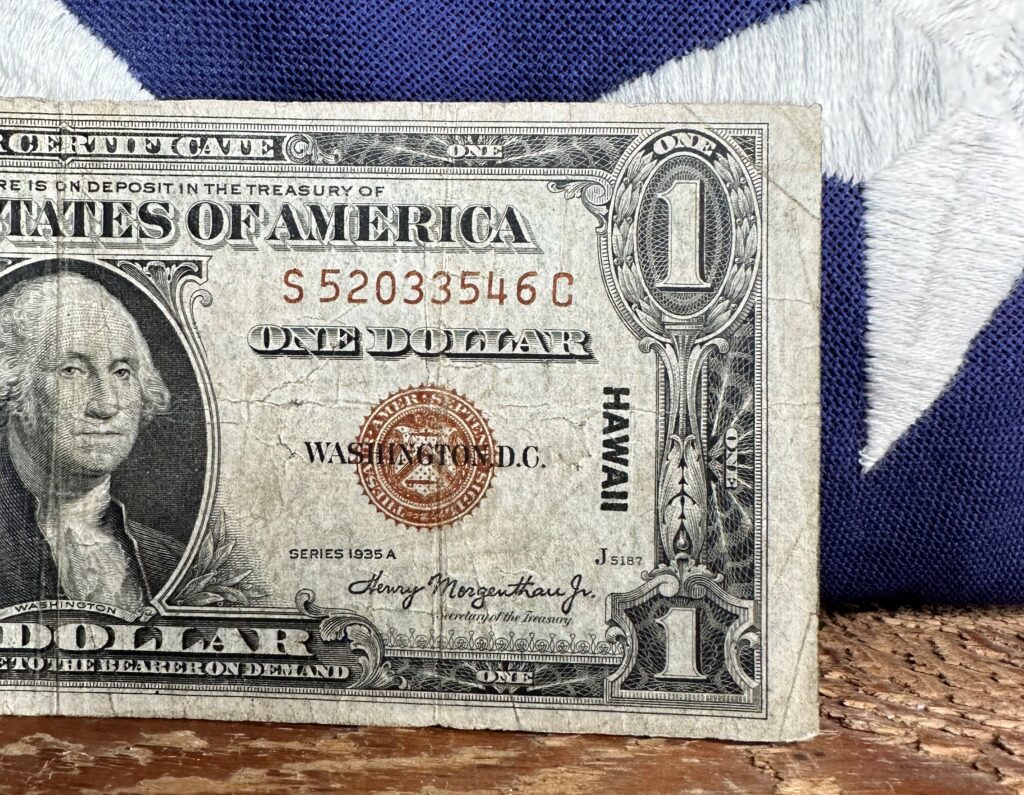


I have a 1dollar note and a 20 on the 1 the numbers are 05050550 and on the 20 then
Numbers are 00010101 who would buy these help me out if you can?